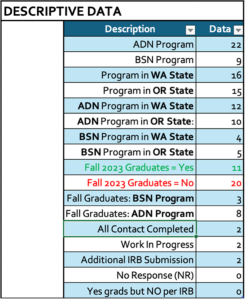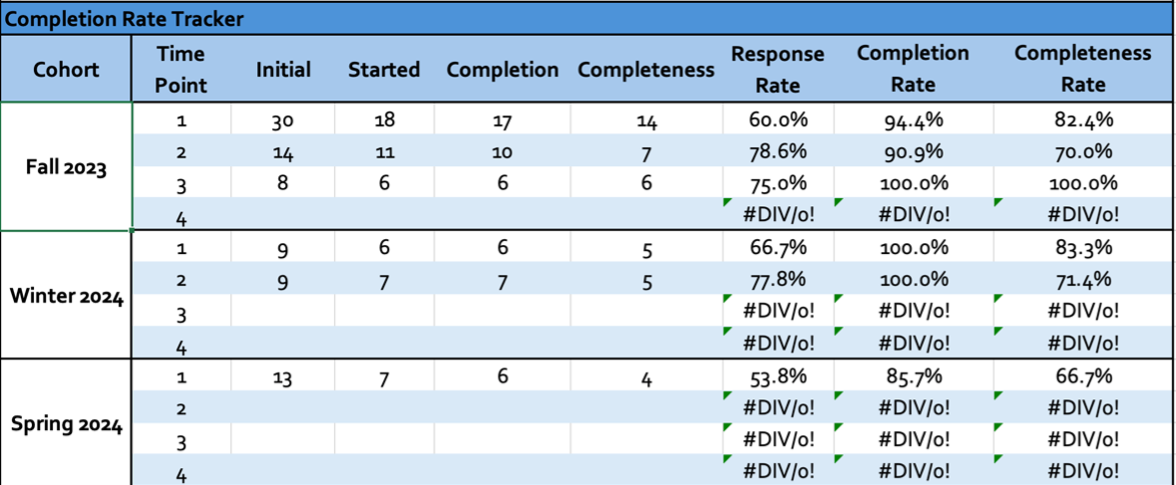Natasha Barrow, [email protected] and Dr. Connie Kim Yen Nguyen-Truong, [email protected]
Two Core Data Tracker Tools for primary data collection – the Core Field Notes-Based Data Collection Tracker and the Core Data Statistics Tracker – were created to plan, implement, and evaluate a mixed method longitudinal research on nursing student burnout and its impact on transition to practice and intent to leave.
There is a critical nursing shortage worldwide, with the loss of nurses outpacing the introduction of new nurses to the workforce. In the United States (U.S.), between 2022 and 2032, there is an estimated need of approximately 193,000 nurses per year due to losses related to retirement and workforce exits.1,2 There is also a projected 6% employment growth in the U.S., approximately 177,000 nurses by 2032.2 In the U.S., an average of one out of five newly licensed registered nurses (NLRNs) will leave the field within the first year, and by two years, over 1/3 more will leave the nursing field.3-5 This loss equates to about 31,000 nurses the first year and an additional 40,000 NLRNs the second year.6 The U.S. graduates approximately 155,000 nurses per year, which creates a deficit between need and supply of approximately 38,000 nurses each year.6 What is even more concerning is that enrollment into nursing programs has decreased by about 10% [88,960 enrolled in 2023] which contributes to shortages based on projected national needs in the workforce.1 Research shows the nursing shortage is a rapidly growing public health crisis.
While this is a critical crisis, this nursing shortage is not limited to the U.S. Canada documented a 60,000-nurse shortage in 2022, with predictions up to 117,000 nurse shortage by 2030.7 The European Union, in their Nurses’ Early Exit Study (NEXT) showed an average of 9.3% of new European Nurses leaving the healthcare field.4 In 2022, the International Council of Nurses (ICN) released a report indicating a need of 13 million more nurses over the next decade worldwide. NLRN’s are needed to close the gap, however this data shows a high trend of loss of NLRN both nationally and internationally.7 An identified gap in the literature is whether there is a relationship between burnout, perceived stress, and generalized health on intent to leave the nursing workforce after the first six months post-graduation. A secondary gap is whether there is a connection between burnout levels in graduating nurses, burnout levels after 6-months post-graduation, and intent to leave the nursing workforce.
In 2023, a literature search in major databases, Cumulative Index to Nursing and Allied Health Literature (CINAHL), PubMed, and SearchIT, with a combination of keywords, included mixed methods, burnout, nursing student, longitudinal research, showed a paucity in research, specifically on the impact of burnout in the final academic term and within the first six months post-graduation specific to intent to leave the workforce for Associate Degree of Nursing (ADN) and Baccalaureate of Science in Nursing (BSN). The Doctor of Philosophy (PhD) Candidate in Nursing (first author) designed, implemented, and debriefed with 3 Nursing (second author & third author) and Health Science (fourth author) faculty scientists on a systematic longitudinal mixed method research to examine the impact of burnout, stress, and sociodemographic data on intent to leave the workforce. Nursing students and NLRNs are caring for the growing needs of diverse populations in many nursing practice areas (e.g., public health/population health/community health, acute and critical care, medical-surgical, emergency care, ambulatory, operating care, palliative care, hospice care, administration, management, education, and more can be found at https://www.aacnnursing.org/news-data/fact-sheets/nursing-workforce-fact-sheet).8 We are cognizant that research on the impact of burnout on nursing student transition to practice from a mixed methods and longitudinal cohort study lens is emerging.9
Thus, the purpose of this brief article is to describe the strategic creation, implementation, and evaluation on strengths, modifications, and utility (i.e., usefulness) of 2 Core Data Tracker Tools with 6 key data areas for primary data collection – Core Field Notes-Based Data Tracker Tool and Core Data Statistics Tracker Tool, to organize, systematically track, and calculate various data for the quantitative portion of mixed method longitudinal exploratory design of this nature and scope as a foundation to address the identified gap. This addresses rigor in systematic planning, implementing, and evaluating the research on burnout, perceived stress, and generalized health on intent to leave the nursing workforce. This article details rationales examples of collected data, and recommendations for consideration in the utility of such tools. We provide downloadable copies of the Core Data Tracker Tools as Excel spreadsheets intended to be adaptable that include formulas used to calculate descriptive statistics. While this is a mixed method longitudinal research study, qualitative data collected through key informants via one-on-one conversation is not the focus of this article.
The first step of this research was to determine what nursing programs were available in both Washington and Oregon states and which academic terms did they graduate nurses. Using the respective states department of health websites, the PhD Candidate created an excel tracker that allowed for systematic and methodical organization and analysis of the information of all nursing schools. The strengths of this spreadsheet included the school’s name, program type (ADN or BSN), city and state, term of graduation, maximum cohort size, current cohort size, contact person, and contact information. Also included was field note information regarding 1st contact and follow up contact, including observations and impressions on what worked or did not work, and whether additional IRB submission was required. The original Nursing Program Tracker was modified based on data collected on nursing programs for each graduating term (i.e. Fall 2023, Winter 2024, Spring 2025). We found this to be an accurate and useful program tracker tool to organize big data and maintain timely field notes-based data. Refer to Figure 1 for example of school related data information specifics in the black highlighted section.


The Core Data Statistics Tracker Tool allowed for tracking and summarizing of data across three cohorts graduating at three different timepoints. Survey data was collected from each of the cohorts at four different timepoints across a 9-month timespan. The strengths of this spreadsheet allowed for calculating data across an individual cohort, and amalgamation of the data into a combined unit for analysis. Using this spreadsheet, the first author organized, synthesized, tracked data related to sample size, response rate, completion rate, completeness, and attrition of both the individual cohorts and combined cohorts. The usefulness of this tracker allowed the first author and team to pool the data from different cohorts into one spreadsheet and see the entire scoping picture of the data rather than data from individual cohorts.

The next step in this process was the attrition rate tracking. The strength of the attrition rate tracker allowed for real time analysis of student attrition of the study. Attrition rate was examined from an individual cohort perspective, a combined completeness perspective, and attrition by sample size. The PhD candidate created formulas using the Excel Sum function (addition of numbers within a designated range), and division with percent formatting to calculate the attrition rates. The attrition data tracker helped with regular assessment of study sample size through participant engagement and attrition rates. Refer to Figure 4 for a sample of the attrition rate data tracker.

The last data set on the overall statistics tracker was sample size tracking. Sample size was assessed per cohort (Fall 2023, Winter 2024, Spring 2024), combined per time point, and assessed with completeness survey submission. The SUM function in Excel was used to calculate this data. The sample size tracker in combination with the attrition rate tracker allowed for the overarching picture of participant engagement and attrition. Refer to Figure 5 for a visual display of the sample size tracking.


Dr. Connie K Y Nguyen-Truong (she/her/they) is a tenured Associate Professor at Washington State University, Department of Nursing and Systems Science, College of Nursing in Vancouver. She is recognized as a Martin Luther King Jr. Community, Equity, and Social Justice Faculty Honoree, March of Dimes Distinguished Nurse Hero, and by the American Association Colleges of Nursing for Excellence and Innovation in Teaching. She is a Fellow of the National League for Nursing Academy of Nursing Education, American Academy of Nursing, and Coalition of Communities of Color Leaders Bridge – Asian Pacific Islander Community Leadership Institute. Her program of research is cross-sectoral and multidisciplinary/transdisciplinary, and with community and health organizations and leaders, community health workers, student scholars, and scientists. Areas include mentorship, health promotion and health equity, culturally specific data and disaggregated; immigrants, refugees, and marginalized communities; community-based participatory/action research and community-engaged research; parent/caregiver leadership, disability leadership justice, and early learning; diversity and inclusion in health-assistive and technology research including adoption; cancer control and prevention, and anti-racism. Dr. Nguyen-Truong received her PhD in Nursing, including health disparities and education, and completed a Post-Doctoral Fellowship in the Individual and Family Symptom Management Center at Oregon Health & Science University School of Nursing.
Natasha Barrow is a tenured faculty at Bellingham Technical College, Nursing Department, in Bellingham Washington. She is a PhD Candidate in the College of Nursing at Washington State University Spokane Health Sciences. Her research interests include equity and diversity in healthcare and education, and researching health and wellness, burnout, and compassion fatigue in nursing students and licensed nurses.
Dr. Denise Smart is a Professor at Washington State University, College of Nursing. Her research focuses on civilian and military health care workers and nurse’s safety and well-being, burnout, and compassion fatigue. She has received several awards from a military research funding agency for her work with National Guard medical personnel and other military disaster response teams focusing on simulation and skills for medics, military nurses and other health care providers, sleep quality, safety and heat injury assessment and prevention. She recently was awarded the 2024 YWCA Woman of the Year for Science, Technology and Environment for her work with nursing students, junior faculty, and military personnel that improves the lives of nurses and other health care team members.
Dr. Lois James is the Assistant Dean of Research and an Associate Professor in the Washington State University (WSU) College of Nursing, where she focuses on the impact of sleep loss, fatigue, stress, and bias on performance and safety in shift workers such as police officers, firefighters, health care personnel, and military personnel. She has received multiple honors and awards for her work and is internationally recognized as a leading expert in her field. She specializes in developing, implementing, and evaluating fatigue risk management and sleep education programs. She is also the founding director of Counter Bias Training Simulation (CBTsim), a novel and innovative simulation-based anti-bias training program that has been featured in National Geographic and the feature-length documentary “bias.” Dr. James’s work has been published extensively in academic journals, practitioner magazines, and mainstream media such as the New York Times and the Washington Post. During her time at WSU, James has brought in approximately $7,000,000 of extramural funding, making her an important contributor to WSU’s “Drive to 25” goal of being recognized as one of the nation’s top 25 public research universities, preeminent in research and discovery, teaching, and engagement by 2030.
BCPHR.org was designed by ComputerAlly.com.
Visit BCPHR‘s publisher, the Boston Congress of Public Health (BCPH).
Email [email protected] for more information.
Click below to make a tax-deductible donation supporting the educational initiatives of the Boston Congress of Public Health, publisher of BCPHR.![]()
© 2025-2026 Boston Congress of Public Health (BCPHR): An Academic, Peer-Reviewed Journal
All Boston Congress of Public Health (BCPH) branding and content, including logos, program and award names, and materials, are the property of BCPH and trademarked as such. BCPHR articles are published under Open Access license CC BY. All BCPHR branding falls under BCPH.
Use of BCPH content requires explicit, written permission.